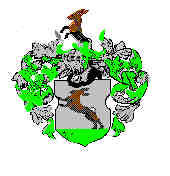
This is the van Haselen family's the coat of arms .
 An
ancient family, whose name changed slightly by the times: via
Van Hasel and Van Haesel (from 1457 dates the variation Van
Hazelt, cook
to the Duke of Cleve, Johan I) until the recent Van Haselen. Including
some
other slips of orthography.
An
ancient family, whose name changed slightly by the times: via
Van Hasel and Van Haesel (from 1457 dates the variation Van
Hazelt, cook
to the Duke of Cleve, Johan I) until the recent Van Haselen. Including
some
other slips of orthography.
And I must admit that some links are slightly less than secure, but the
probabilities in the family links are considerable. Even when not all
data can be
asserted with the help of baptismal register and the like, since often
they
are disappeared, totally or partly. The orthography of a name was never
a matter
of great interest in bygone ages, it was like in the days of the
Judges:
everybody did as appeared good in his or her eyes.
As a family we owe a lot to the unsurpassed work Piet van Haselen, who finished his Chronicles of the Family Van Haselen, (Van Hasel - Van Haesell) in 1941. It exists in stenciled form.
As to Aelbrecht van Hazelt, married with Mechtelt Leers, he died after 15 June 1496. His name is sometimes written as Van Haesell, at the same time he is indicated as Kaick, a word that has to do with his function as cook. He owed a horse, and was obviously in high respect by the Duke, for he and his descendants receive regularly favors. His widow gets a pension of 2 ´malder´ rye and 2 ´malder´ barley for live, to receive from the financial office of the dukedom of Cleve. I have no clue how much a malder is, but no doubt it will be enough to get her through the winter.
Regarding the Coat of Arms: they consist of an
rising hare
in natural colors in a silver field on grass. Helmet sign a appearing
hare.
Cover and roll are in silver and green.
This coat of arms we find by Wijnand van Hasel, (van Haselen), who ran
a tobacco
plantation and traded the same. He died in 1762. The original sealing
wax
consisted of an coat of arms in four, a so called alliance coat of
arms. First
and third quarter a rising hare, symbol of the Van Hasel)en family, and
in the
second and third quarter a rising lion, presumably symbol of the family
Van den Hogenboom,
since he was married to Maria van den
Hogenboom.
The psalm you heard on opening this page (90), that
this usually religious family, choose as a
spiritual coat of arms was in 1708 rewritten by William Croft as:
O God our help
in ages past, our hope for years to come, our shelter from the stormy
blast, and
our eternal home ... It ends with: Be Thou our guard while
troubles
last, and our eternal home.
The family consisted in the fifties of the 20th century
mainly of two branches, a Rereformed one (Gereformeerd) in the
city of
Amersfoort and a Reformed one (Hervormde) around Loosdrechtse.
O God, Die droeg ons voorgeslacht - in nacht en stormgebruis, - bewijs ook ons Uw trouw en macht. Wees eeuwig ons tehuis! This song still will be sung at a lot of marriages and burials in the family. (Liedboek der kerken 397)
The family can be found in various parts of the United States of America, and even in South - Africa. Who of the younger ones is going to arrange a family gathering, as there was in the fifties?
| go up |